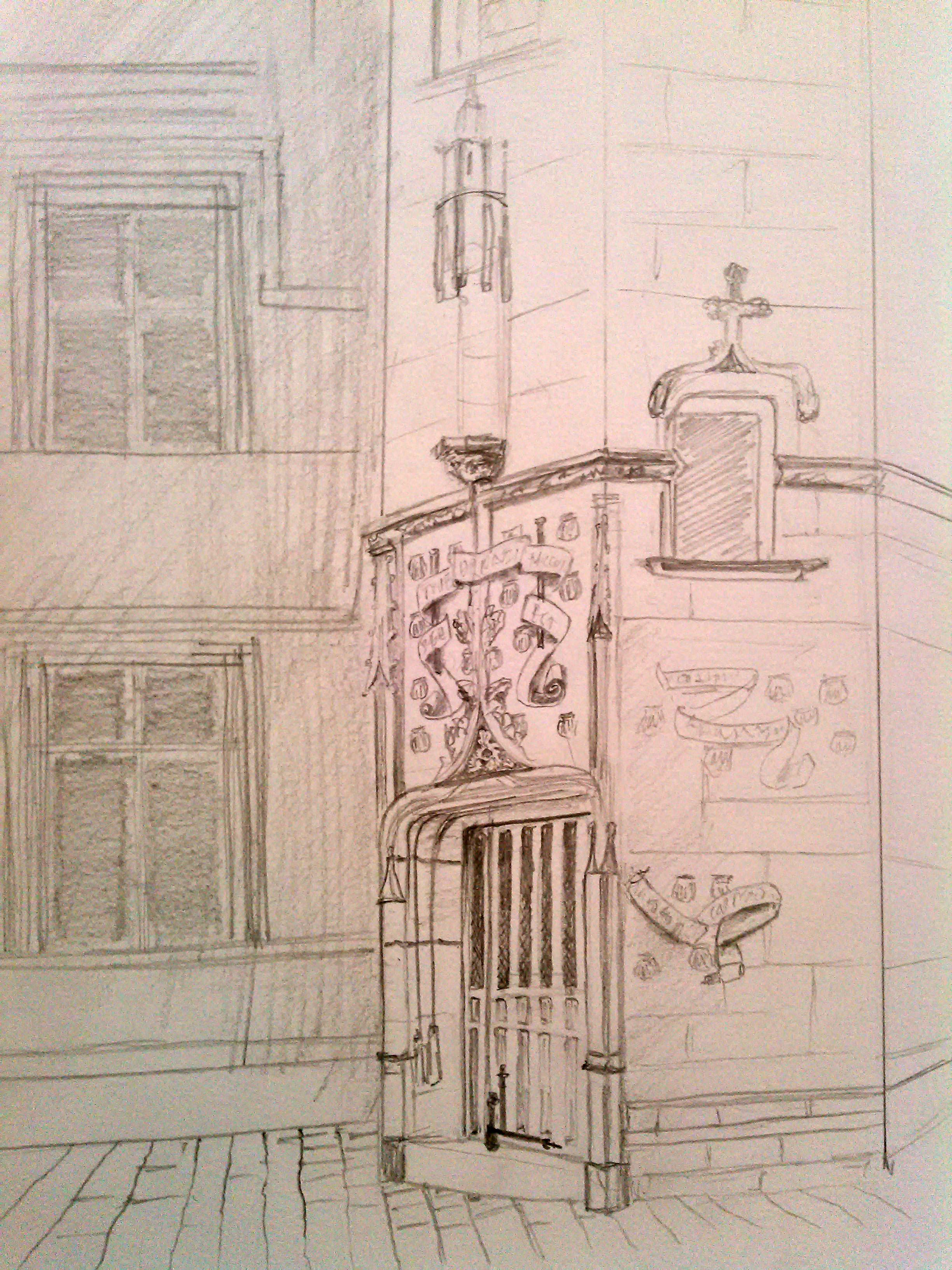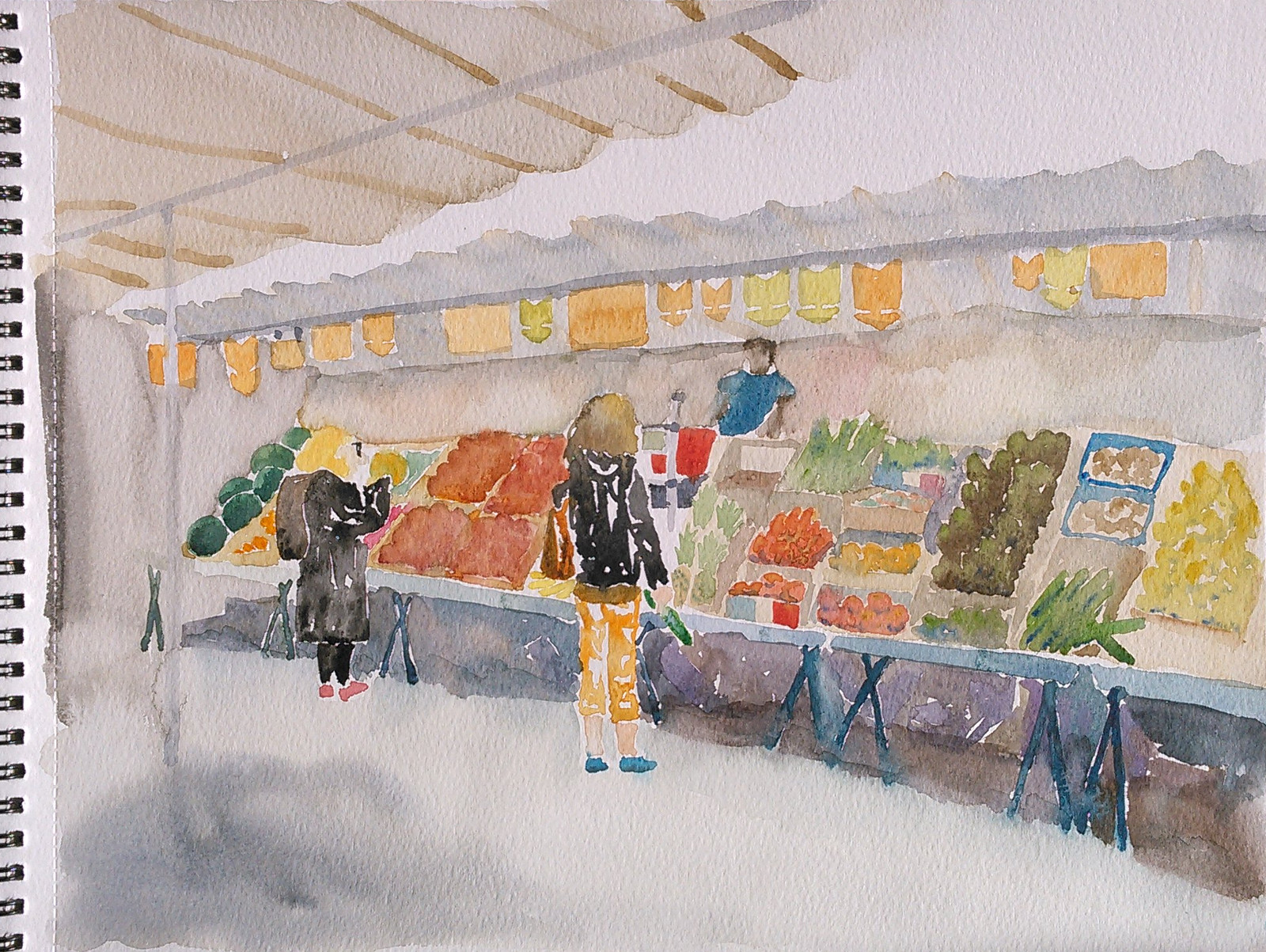Just after the drawing class with Savoir/Dessiner, I attended another course with Atelier Alupi. It was the same format: one drawing on location in a new place in Paris each day, for six days.
Musée de Cluny
The Cluny museum is about the Middle Ages, but I can’t say much more because I have yet to visit it. What I can tell you is that the entrance courtyard is a nice drawing subject, thanks to its ornate walls, doors and windows.
The first day of the class was only about drawing. I focused on a door that was topped by a intricate combination of stone-carved scrolls and clamshells. Before starting the full-page drawing, we made a smaller version to check the composition.
I didn’t have time to reproduce all the details of the carving, and even less time to draw correctly the windows in the background. Solution: gray them out, so that it’s clear that they’re in the background and so the viewer doesn’t try to look at them too hard.

View from the Pont des Arts
On the second day, we sat on the Pont des Arts, from which you get a nice view on the Seine and the City island. The technique we studied that day is called wash drawing (lavis in French) and is basically watercolor with only one color. I used Payne’s grey, which is a mixture of black and blue that is usually used for shadows.
We painted directly, without any previous drawing on the page. It forced me to think before each stroke, but in the end I found that enjoyable and tried to proceed in the same way during the following days.
Since you only play with contrasts, it’s important to make sure that the most important elements stand out as foreground and background. A technique to get a better intuition of what should be dark and light is to look at the scene while squinting.
The dramatic sky is representative of the weather that day. The big clouds were threatening and it actually rained for a few minutes in the middle of session, which produced the white dots at the top of the painting (fortunately the rest of it was under an umbrella).

Marché Maubert
That day, we settled in a street market called the Marché Maubert. It’s quite small and focused on organic food. I set up my folding chair in front of a fruit and vegetable stand. I tried to paint a few passersby, and at some point I fell into a never-ending quest to Draw Every Single Vegetable, which of course I did not have time to complete.
For this one, I painted without a drawing, but it may have helped to have at least the most important lines to get a better perspective. For example, the shadow under the vegetable stands was incorrect at first, and I had to paint and “extension” in the bottom-right corner.

Jardin du Luxembourg
The Luxembourg Garden is a beautiful park in Paris, just next to the French Senate. It has trees, flowerbeds, water basins, statues and lots of chairs everywhere, all of which make it ideal for drawing and painting.
The goal of the class was to study the difference between light and shadow, using those two flower pots. One was in the sunlight, the other in the shade of a tree. In the end, I should have insisted more on the differences in color between the two.

Pont Alexandre III
Once again painting from the banks of the Seine, we studied the Alexander III bridge. We tried to use only two colors, one for the light and another for the shadows. This time I drew again before painting, both a small composition sketch and a full-page drawing.

Notre Dame
Finally on the last day, we painted the iconic Notre Dame de Paris cathedral, as seen from the Saint Louis island (i.e. from behind).
I’m quite satisfied with that one because I think it’s the first of my paintings that is a bit “understated” and looks more like watercolors than gouache.

As a conclusion, I enjoyed a bit more the previous drawing course, for two reasons. The first is that this course lasted only two hours and a half just before lunch, and it was often not enough for me to finish the painting (and afterwards I was hungry so I just went home to eat). The second one might be that after learning basic but very important techniques in the first course, I should have spent some time practicing that before starting another course straight away. At times I felt that I was still practicing the techniques from the previous class instead of benefiting from new advice from this new teacher. That being said, the selection of locations for the course was fantastic, and the whole experience was once again very enjoyable.